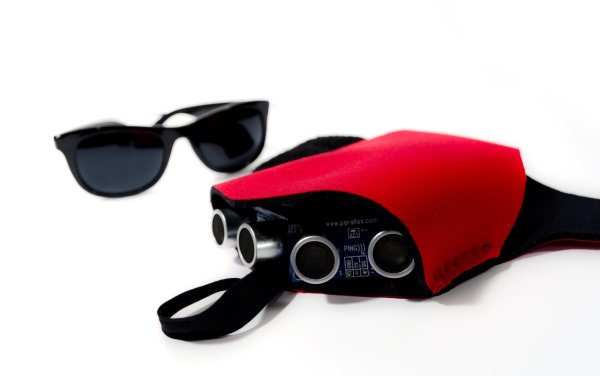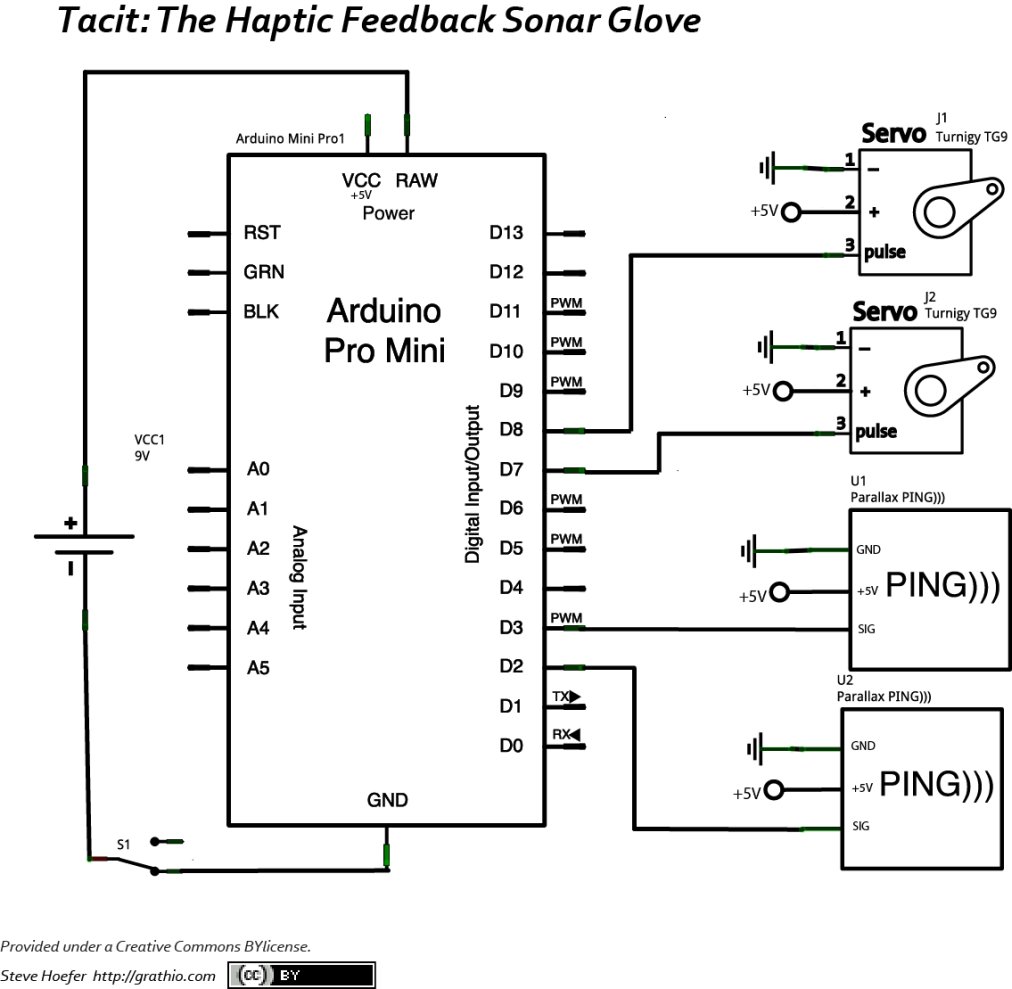This is a project I’m calling Tacit. No, I didn’t bother making an awkward backronym for it, it just seemed like an appropriate name that’s a lot shorter (though less descriptive) than “Hand-Mounted Haptic Feedback Sonar Obstacle Avoidance Asstance Device”. It measures the distance to things and translates that into pressure on the wrist.
It’s wrist mounted and senses objects from about 1 inch (2 cm) to 10 feet (3.5m). It has generally fast response time (fractions of a second) to quickly navigate complex environments. It’s designed to help a vision impaired person to navigate complex environments. Mounted to the back of the hand, the force feedback means it doesn’t interfere with other assistance devices that mount elsewhere and use audio feedback cues. The learning curve is measured in seconds, everyone who has worn it has figured it out immediately. Here’s a short video that give more information and shows it in action.
This is the first public prototype. It’s not perfect, but it works, and it can be better. For example it could easily be made about half the size, and the replaceable batteries should be replaced by rechargeables with a blind-friendly charging method, either wireless or magnetically-aligning power plug.
This is vastly different from the first version which was a headband, very similar to the (independently developed) haptic headband. Just like Instructables user polymythic, my headband had ultrasonic sensors and vibration motors around the circumference of a headband with the motors vibrating faster the closer they came to an obstacle. I looked at infrared sensors too but found that sunlight, remote controls, security cameras, and absorbent surfaces easily confused the sensors. Ultrasonics are much larger and harder to focus but they’re good in just about any environment. I plan to do some more tests with IR using different wavelengths and polarizing filters, but for now ultrasonics work best at this price. Lasers would be the most accurate, but would increase the cost dramatically.
The headband was a great first test, and it did work, but it had two fatal flaws:
- The most dangerous obstacles are not at head level. Furniture and most of the other things that can be tripped over and stubbed on are waist level or lower.
- Vibrating motors stuck on your skull will drive you insane quickly.
In addition it would be a challenge to disguise it as anything but some mad-science-looking headband, and blind people do care how they look.
I looked at a number of solutions to getting the sensors to look in a more useful direction. For the blind, vision-simulating sensors don’t need to be attached to the head, that’s a sighted prejudice. There is not shortage of other projects to look at, like haptic vests and vision processing systems, but they were generally cumbersome and universally very expensive. I don’t see the point of an accessibility device that has an inaccessible price tag. (The cost of materials in the prototype is around $65USD retail.) In the end mounting it to the hand was the best solution. It’s in about the right location, lets the wearer quickly and easily point it at anything they’re curious about, and generally won’t interfere or be interfered with by most clothes and other limbs.
Even though it’s no longer head mounted the vibration motors are still a problem in several ways. They’re noisy and audio feedback is important for the visually impaired. More importantly even small vibrations, if they’re constant, can cause nerve damage. The idea of solenoids came up since they can be small and have a fast response time, but they are either on or off, and don’t provide any in-between. Other solutions like pneumatics and linear actuators were slower than I wanted. There are some experimental muscle materials out there which are intriguing, but not generally available at the moment. After some testing I decided to use some small servomotors with cushions on the ends, these can be quickly and precisely positioned in a lot of positions and give higher fidelity than solenoids. And small ones are cheap.
[box color=”#985D00″ bg=”#FFF8CB” font=”verdana” fontsize=”14 ” radius=”20 ” border=”#985D12″ float=”right” head=”Major Components in Project” headbg=”#FFEB70″ headcolor=”#985D00″]Components here[/box]
For more detail: Sonar For The Blind using Arduino


